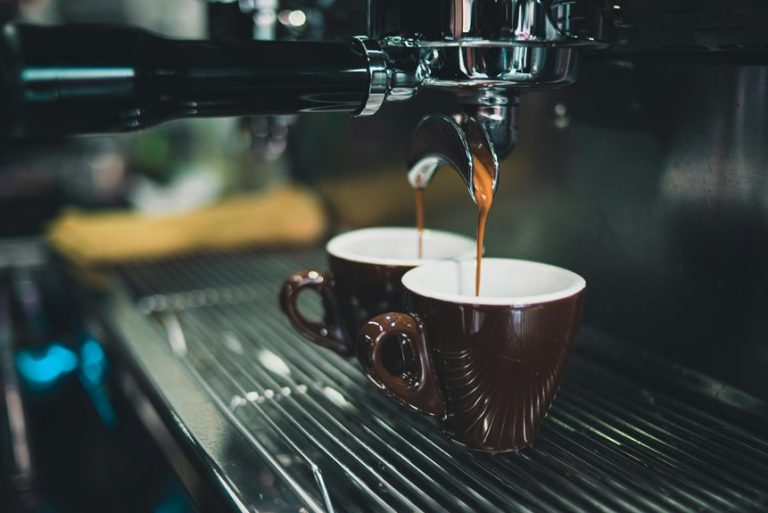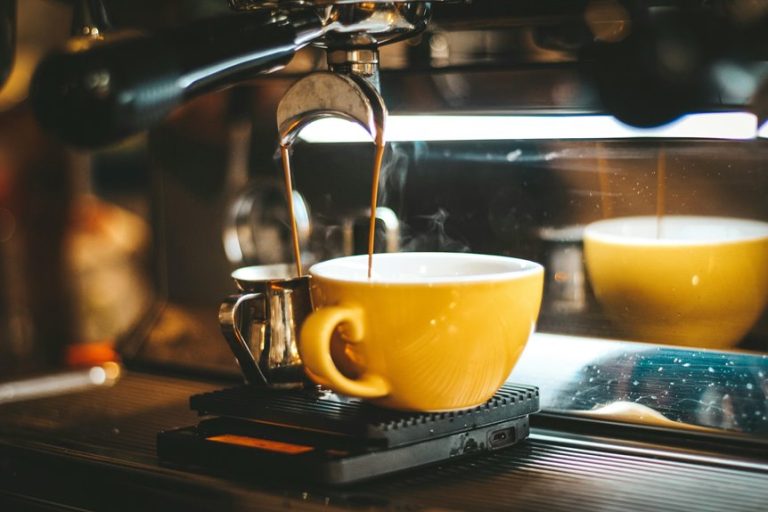Espresso Vs Coffee Caffeine Which One Packs a Punch?

I've always found the debate between espresso and coffee fascinating, particularly when it comes to their caffeine content. While it's commonly assumed that espresso might be the stronger contender due to its bold flavor and concentrated form, the reality isn't as straightforward as one might think. Consider this: a single shot of espresso does pack more caffeine per ounce, but a regular cup of coffee typically holds more caffeine overall due to its larger volume. This raises an intriguing question about how we perceive strength and how it influences our choice of brew. So, what might this mean for your daily coffee ritual?
Understanding Espresso and Coffee
Most people don't realize that both espresso and coffee originate from the same beans; the primary difference lies in their brewing methods.
Espresso's origins trace back to Italy, designed for quick preparation under high pressure, extracting rich flavors rapidly.
Coffee varieties, meanwhile, are brewed more slowly, allowing for diverse flavor profiles from different regions, each influencing the taste and aroma of your morning cup.
Caffeine Content: Espresso vs. Coffee
Understanding the distinct brewing processes of espresso and coffee sets the stage for exploring their caffeine differences. The espresso intensity often leads people to think it's the stronger punch. But, let's break it down with some specifics:
| Aspect | Espresso | Coffee |
|---|---|---|
| Serving Size | 1 oz | 8 oz |
| Caffeine | 63 mg | 96 mg |
| Brew Time | 30 seconds | 5 minutes |
| Flavor | Strong, rich | Milder, varied |
Despite its robust flavor, espresso has less caffeine per serving than coffee.
How Brewing Method Affects Caffeine
As we explore how brewing methods impact caffeine levels, it's essential to understand that each technique can greatly alter the amount of caffeine extracted.
Factors like the temperature of the water used can also play a pivotal role; for instance, higher temperatures tend to extract more caffeine.
Caffeine Levels by Method
When exploring the impact of brewing methods on caffeine content, it becomes clear that the technique employed plays a pivotal role in determining the strength and potency of your coffee.
Caffeine extraction varies greatly with brewing variables like grind size, water flow, and contact time. Espresso, with its fine grind and high pressure, typically extracts more caffeine quicker than drip coffee methods.
Temperature Impact on Caffeine
Turning up the heat on our brewing process reveals how temperature also plays a critical role in caffeine extraction. Higher brewing temperatures boost extraction efficiency, enhancing both caffeine and flavor extraction.
Yet, each coffee type has its own temperature tolerance. Excessive heat impacts thermal stability, potentially degrading delicate flavors.
Conversely, lower temperatures may require longer exposure, balancing extraction rates and cooling effects amidst temperature variations.
Serving Sizes: A Comparison
Understanding the differences in serving sizes between espresso and regular coffee is essential for making an informed decision about your caffeine intake.
Standard espresso shots typically range between 1 to 1.5 ounces, while coffee mugs hold about 8 ounces.
This variance affects your daily intake, shaping caffeine preferences, portion control, and overall consumption habits.
Accurately gauging these can optimize your beverage choices for better health management.
The Impact of Roast Levels
Exploring the impact of roast levels on espresso and coffee reveals significant differences in flavor, aroma, and caffeine content.
Light roast often retains more of the roast origin's unique characteristics, enhancing roast acidity and sweetness, while dark roast deepens roast flavor and aroma, reducing perceived acidity but increasing roast intensity.
The transformation in beans affects not just taste but also how we experience caffeine's kick.
Health Benefits and Drawbacks
As we compare the caffeine content in espresso and coffee, it's essential to understand how this influences our health.
While both beverages boast benefits like increased alertness and potential antioxidant intake, they also pose risks such as heightened anxiety and sleep disruption.
Carefully considering these factors will help us gauge not just the immediate perks but also the long-term effects on our well-being.
Caffeine Content Comparison
Over the years, many have debated whether espresso or regular coffee offers more caffeine per serving, an essential factor for those watching their intake for health reasons.
Generally, espresso contains more caffeine per ounce, which can spike energy levels quickly.
However, the faster caffeine absorption from espresso could lead to shorter-lived alertness compared to the gradual effect from a regular cup of coffee.
Health Risks Considered
Despite the popularity of both espresso and regular coffee, it's essential to evaluate their health implications before making them a staple in your daily routine.
Those with caffeine sensitivity may experience adverse effects, making it crucial to adhere to health guidelines on consumption.
Overindulgence can lead to sleep disturbances and increased anxiety, underscoring the importance of moderation and awareness of one's personal tolerance levels.
Flavor Profiles Explained
When we investigate the flavor profiles of espresso and regular coffee, it's clear that the distinctions are profound and significant.
- Aroma Profiles: Espresso's intense, concentrated scent versus coffee's milder bouquet.
- Tasting Notes: Sharp, rich espresso vs. nuanced, layered coffee flavors.
- Flavor Balance: Espresso strikes with boldness; coffee offers subtlety.
- Regional Variations: Espresso and coffee reflect their unique origins, influencing palate preferences deeply.
Popular Espresso and Coffee Drinks
As we explore popular espresso and coffee drinks, it's essential to understand the nuances between classic espresso varieties and our favorite coffee selections.
We'll compare brewing techniques, noting how they influence the flavor and caffeine content of each drink.
This analysis will help you appreciate the craftsmanship behind your daily cup, whether it's a robust espresso or a delicately balanced pour-over.
Classic Espresso Varieties
Exploring the array of classic espresso varieties reveals a rich tapestry of flavors and brewing traditions that distinguish each from the ordinary cup of coffee.
- Espresso Ristretto: Concentrated intensity, capturing the essence of espresso origins.
- Caffè Americano: A fusion of robust espresso and water, highlighting brewing variations.
- Cappuccino: A harmonious blend of froth and flavor, showcasing espresso rituals.
- Macchiato: Subtle flavor nuances meet bold espresso types.
Favorite Coffee Selections
Building on our understanding of classic espresso varieties, let's now examine some favorite coffee selections that have captured the hearts of enthusiasts around the globe.
Favorite blends like the Colombian Supremo offer rich, nutty tasting notes, while Ethiopian Yirgacheffe delivers floral hints with a touch of citrus.
Each selection provides a distinct profile, thoroughly enhancing the coffee experience by highlighting unique characteristics inherent in their origins.
Brewing Techniques Compared
Why do different brewing techniques matter when it comes to enjoying your favorite espresso or coffee drinks? The nuances of brewing methods drastically influence your beverage:
- Extraction Time: Longer or shorter can mean bitter or sour.
- Grind Size: Impacts extraction, defining flavor.
- Temperature Control: Guarantees ideal flavor release.
- Pressure Levels: Essential for that perfect espresso crema.
Each factor, from water quality to brewing equipment, shapes your coffee experience.
Tips for Maximizing Caffeine Intake
If you're looking to maximize your caffeine intake from espresso or coffee, understanding the variables that affect caffeine content is essential. Consider caffeine timing and hydration balance to optimize effects. Here's a quick guide:
| Factor | Espresso | Coffee |
|---|---|---|
| Brew Time | Short | Long |
| Bean Type | Robusta | Arabica |
| Serving Size | Smaller | Larger |
Choose wisely to boost your caffeine levels effectively!
Cultural Preferences and Trends
While the choice between espresso and coffee often hinges on personal caffeine preferences, it's also deeply influenced by cultural trends and societal norms.
The role of coffee and espresso in various societies reflects:
- Historical significance of coffee culture and espresso traditions.
- Craft movements shaping taste evolution.
- Cultural rituals at social gatherings.
- Regional variations influencing beverage preferences and consumption habits.
These elements profoundly shape our daily coffee or espresso choices.
Conclusion
To summarize, choosing between espresso and coffee largely depends on your caffeine preferences and taste profile. While espresso offers a concentrated burst with higher caffeine per ounce, a standard coffee cup provides more overall caffeine due to larger serving sizes. Understanding the brewing methods, roast levels, and flavor nuances can greatly enhance your beverage experience. Whether you're seeking a robust flavor or a caffeine boost, both drinks have distinct qualities that cater to diverse palates and needs.






